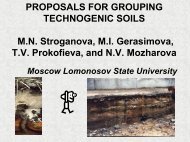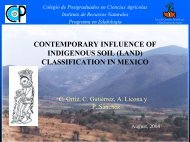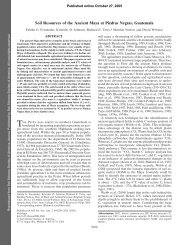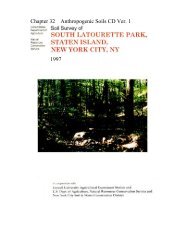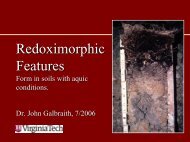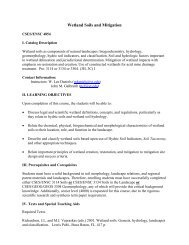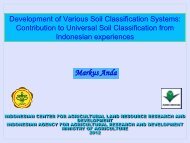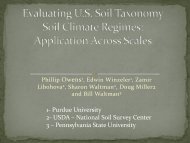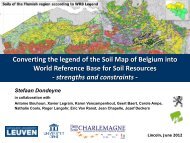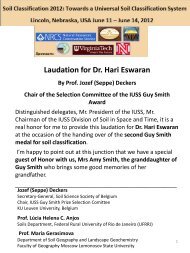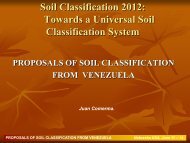Nebraska Soils Field Trip - Virginia Tech
Nebraska Soils Field Trip - Virginia Tech
Nebraska Soils Field Trip - Virginia Tech
Create successful ePaper yourself
Turn your PDF publications into a flip-book with our unique Google optimized e-Paper software.
4th IUSS Soil Classification Conference <strong>Field</strong> Tour Guidebook<br />
Glacial till derived soils in MLRA 107B<br />
by: Patrick Cowsert, RSS, Stanton <strong>Nebraska</strong><br />
The landscape in MLRA 107B is dominated by a thick deposits of Wisconsin age loess which overlays<br />
pre-Illinoisan glacial till. The pre-Illinoisan glacial period was between 500,000 and 2.5 million years<br />
ago during the early to middle Pleistocene Era. The pre-Illinoisan period was once thought to consist of<br />
two distinct glacial events, however it has had 11 distinct glacial stages identified during that time.<br />
During the post glacial period, a till paleosol developed which was later exposed in some places. The<br />
landscape that developed in the glacial till dictated the larger 1 st order stream valleys prior to, and after,<br />
loess deposition. As the loess landscape developed and the loess blanket was eroded and the secondary<br />
drainage systems developed, the glacial till was re-exposed. In some locations the till is exposed in<br />
isolated areas in the upland sideslopes and in others the drainageways are so entrenched and the degree of<br />
erosion on the side slopes is so great that little or no loess can be found over the till. The exposed till in<br />
some areas has been truncated and the paleo-surface eroded away.<br />
The exposed till is characterized by generally little<br />
sorting with a variety of rock fragment sizes throughout<br />
the soil profile. Many hillsides of glacial derived soils<br />
are scattered with glacial erratics . The till is well<br />
drained, but relict redoximorphic concentrations and<br />
depletions from a previous climatic period are common<br />
with coarse to extremely coarse features visible.<br />
Manganese is associated with the iron in the<br />
concentrations. Calcium carbonate is common and<br />
ranges from free calcium carbonate to soft masses and<br />
nodules to concretions which can be quite large. Many<br />
stones have a rind of calcium carbonate on the lower<br />
side. Some pedogenic development has begun on these<br />
till exposures and soil structure and clay films are present<br />
in some soils.<br />
Pre-Illinoian glacial till is calcareous and it has an<br />
average clay content of 24 to 35% clay and an average<br />
sand content of 20-40% with some pedons as high as<br />
52%. The typical soil texture is clay loam or loam with<br />
loam, silt loam or silty clay loam at the surface. Rock<br />
fragments are generally less than 10% of mixed origin.<br />
Mean annual temperature ranges from 10 to 13 degrees C, and mean annual precipitation ranges from 71<br />
to 86 centimeters with some areas as high as 94 centimeters. Average frost-free period ranges between<br />
130 to 180 days with some areas 200 days.<br />
The glacial derived soils of this area, in order from least to most developed are: Steinauer, Liston,<br />
Burchard, and Shelby. The Steinauer and Liston soils are usually found on more eroded landscape<br />
positions on steeper side slopes and exposed nose slopes (see figure 4). The slope range here is from 5 to<br />
75% slope. Steinauer soils are an AC profile with non-pedogenic free calcium carbonate to the surface.<br />
Liston soils have a B horizon. Next are the Burchard and Shelby soils (see figure 2 and 4). The slope<br />
range is 2 to 40 % slope. Burchard soils have a mollic epipedon and are leached of carbonates in the<br />
upper part. Shelby soils have a thicker mollic epipedon and are leached to a greater depth.<br />
146



